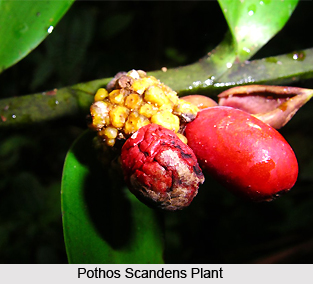 Pothos scandens is the botanical name of the plant that is known as Anaparuga in Tamil. The Indian medicinal plant has separate names in several Indian languages. For instance, Pothos scandens is known as Adikabiluballi in Kannada and Anapparuva or Paruvakodi in Malayalam. It is a climbing shrub having adventitious aerial roots. The internodes of the plant are 1.3-2.5 cms and its leaves are very variable. The leaves are obovate, elliptic or lanceolate and coriaceous, having a bright green colour. The apex of the plant is acute, acuminate or apiculate, with cuneate or rounded base.
Pothos scandens is the botanical name of the plant that is known as Anaparuga in Tamil. The Indian medicinal plant has separate names in several Indian languages. For instance, Pothos scandens is known as Adikabiluballi in Kannada and Anapparuva or Paruvakodi in Malayalam. It is a climbing shrub having adventitious aerial roots. The internodes of the plant are 1.3-2.5 cms and its leaves are very variable. The leaves are obovate, elliptic or lanceolate and coriaceous, having a bright green colour. The apex of the plant is acute, acuminate or apiculate, with cuneate or rounded base.
The petioles of Pothos scandens are semi-amplexicaul and broadly winged. They have a length of 2.5-7.5 cm and width of 0.6-1.7 cm at the base. The green Spathe is 0.4-0.7 cm long, ovate and erect, with cuspidate apex. The stipe of the plant is deflexed, to 0.6 cm long and the spadix is yellow, with an approximate length of 0.5 cm. The spadix is globose, ovoid or shortly oblong. The fruits or berries of the plant are oblong and 1.3-1.7 cm long and they are scarlet when ripe. The plant is mainly a native to the Indo-Malaysian region and Madagascar. However, it is commonly found on rocks, walls and tree trunks in moist and wet forests in northeastern, central and southern India. The plant is found in the Andaman and Nicobar Islands, as well.
Pothos scandens has quite a few medicinal properties and usages. The bruised root of the plant is reportedly applied to promote healing of abscesses, after being fried in oil. The Indian people use an infusion of the leaves of this plant as a bath for curing convulsions and epilepsy. Apart from that, the stem is also reportedly used to treat asthma, after being cut up with camphor and smoked like tobacco.



















